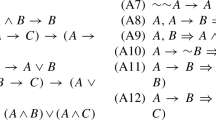Abstract
Mares and Goldblatt (The Journal of Symbolic Logic, 71(01), 163–187, 2006) provided an alternative frame semantics for two quantified extensions of the relevant logic R. In this paper, I show how to extend the Mares-Goldblatt frames to accommodate identity. Simpler frames are provided for two zero-order logics en route to the full logic in order to clarify what is needed for identity and substitution, as opposed to quantification. I close with a comparison of this work with the Fine-Mares models for relevant logics with identity and a discussion of constant and variable domains.
Similar content being viewed by others
References
Anderson, A.R., & Belnap, N.D. (1975). Entailment: the logic of relevance and necessity Vol. I. Princeton: Princeton University Press.
Anderson, A.R., Belnap, N.D., & Dunn, J.M. (1992). Entailment: the logic of relevance and necessity Vol. II. Princeton: Princeton University Press.
Bimbó, K. (2006). Relevance logics. In Jacquette, D (Ed.) Philosophy of logic, handbook of the philosophy of science, (Vol. 5 pp. 723–789): Elsevier.
Bimbó, K. (2015). Current trends in substructural logics. Journal of Philosophical Logic, 44(6), 609–624. https://doi.org/10.1007/s10992-015-9346-x.
Brady, R.T. (1988). A content semantics for quantified relevant logics. I. Studia Logica, 47(2), 111–127. https://doi.org/10.1007/BF00370286.
Brady, R.T. (1989). A content semantics for quantified relevant logics. II. Studia Logica, 48(2), 243–257. https://doi.org/10.1007/BF02770515.
Brady, R.T. (2017). Some concerns regarding ternary-relation semantics and truth-theoretic semantics in general. IfCoLog Journal of Logics and Their Applications, 4(3), 755–781.
van Dalen, D. (2002). Intuitionistic logic, (pp. 1–114). Dordrecht: Springer Netherlands. https://doi.org/10.1007/978-94-017-0458-8_1.
Dunn, J.M. (1987). Relevant predication 1: The formal theory. Journal of Philosophical Logic, 16(4), 347–381. https://doi.org/10.1007/bf00431183.
Dunn, J.M. (1990a). Relevant predication 2: Intrinsic properties and internal relations. Philosophical Studies, 60(3), 177–206. https://doi.org/10.1007/bf00367469.
Dunn, J.M. (1990b). Relevant predication 3: Essential properties. In Dunn, J, & Gupta, A (Eds.) Truth or consequences (pp. 77–95): Kluwer Academic Publishers.
Dunn, J.M. (1993). Star and perp: Two treatments of negation. Philosophical Perspectives, 7, 331–357. https://doi.org/10.2307/2214128.
Dunn, J.M., & Restall, G. (2002). Relevance logic. In Gabbay, D M, & Guenthner, F (Eds.) Handbook of philosophical logic. 2nd edn., (Vol. 6 pp. 1–136): Kluwer.
Ferenz, N. (2019). Quantified modal relevant logics. PhD thesis, University of Alberta.
Fine, K. (1974). Models for entailment. Journal of Philosophical Logic, 3(4), 347–372. https://doi.org/10.1007/BF00257480.
Fine, K. (1983). A defence of arbitrary objects I. Aristotelian Society Supplementary, 57(1), 55–77.
Fine, K. (1985a). Natural deduction and arbitrary objects. Journal of Philosophical Logic, 14(1), 57–107. https://doi.org/10.1007/BF00542649.
Fine, K. (1985b). Reasoning with arbitrary objects. Oxford: Blackwell.
Fine, K. (1988). Semantics for quantified relevance logic. Journal of Philosophical Logic, 17, 27–59. https://doi.org/10.1007/BF00249674.
Goldblatt, R. (2009). Conservativity of Heyting implication over relevant quantification. Review of Symbolic Logic, 2(2), 310–341. https://doi.org/10.1017/S1755020309090194.
Goldblatt, R. (2011). Quantifiers, Propositions and Identity: Admissible Semantics for Quantified Modal and Substructural Logics. Cambridge: Cambridge University Press.
Goldblatt, R., & Kane, M. (2009). An admissible semantics for propositionally quantified relevant logics. Journal of Philosophical Logic, 39(1), 73–100. https://doi.org/10.1007/s10992-009-9109-7.
Humberstone, L. (2011). The Connectives. Cambridge: MIT Press.
Jago, M. (2013). Recent work in relevant logic. Analysis, 73(3), 526–541. https://doi.org/10.1093/analys/ant043.
Kremer, P. (1989). Relevant predication: Grammatical characterisations. Journal of Philosophical Logic, 18(4). https://doi.org/10.1007/bf00262941.
Kremer, P. (1997). Dunn’s relevant predication, real properties and identity. Erkenntnis, 47(1), 37–65. https://doi.org/10.1023/a:1005306200547.
Kremer, P. (1999). Relevant identity. Journal of Philosophical Logic, 28(2), 199–222. https://doi.org/10.1023/a:1004323917968.
Logan, S.A. (2019). Notes on stratified semantics. Journal of Philosophical Logic, 48, 749–786. https://doi.org/10.1007/s10992-018-9493-y.
Mares, E.D. (1992). Semantics for relevance logic with identity. Studia Logica, 51(1), 1–20. https://doi.org/10.1007/BF00370329.
Mares, E.D. (2004). Relevant logic: a philosophical interpretation. Cambridge: Cambridge University Press.
Mares, E.D. (2009). General information in relevant logic. Synthese, 167(2), 343–362. https://doi.org/10.1007/s11229-008-9412-9.
Mares, E.D. (2019). From iff to is: Some new thoughts on identity in relevant logics. In Graham Priest on dialetheism and paraconsistency. https://doi.org/10.1007/978-3-030-25365-3_16 (pp. 343–363). Berlin: Springer International Publishing.
Mares, E.D., & Goldblatt, R. (2006). An alternative semantics for quantified relevant logic. The Journal of Symbolic Logic, 71(01), 163–187. https://doi.org/10.2178/jsl/1140641167.
Moschovakis, J. (2018). Intuitionistic logic. In Zalta, E.N. (Ed.) The Stanford Encyclopedia of Philosophy, winter 2018 edn, Metaphysics Research Lab, Stanford University.
Øgaard, T.F. (2020). Substitution in relevant logics. Review of Symbolic Logic, 13(3), 655–680. https://doi.org/10.1017/s1755020319000467.
Priest, G. (2005). Towards non-being: the logic and metaphysics of intentionality. Oxford: Oxford University Press.
Priest, G. (2008). An introduction to non-classical logic: from if to is. Cambridge: Cambridge University Press.
Read, S. (1988). Relevant logic: a philosophical examination of inference. Oxford: B. Blackwell.
Restall, G. (2000). An introduction to substructural logics. London: Routledge.
Ripley, D. (2018). Blurring: An approach to conflation. Notre Dame Journal of Formal Logic, 59 (2), 171–188. https://doi.org/10.1215/00294527-2017-0025.
Routley, R., Plumwood, V., Meyer, R.K., & Brady, R.T. (1982). Relevant Logics and Their Rivals Vol. 1. Ridgeview: Atascadero.
Schwarz, W. (2013). Contingent identity. Philosophy Compass, 8(5), 486–495. https://doi.org/10.1111/phc3.12028.
Acknowledgements
I would like to thank Greg Restall, Ed Mares, Lloyd Humberstone, Shay Logan, Dave Ripley, Rohan French, and audience members of the Melbourne Logic Seminar and the Australasian Association for Logic conference 2018 for discussion and feedback. This research was supported by the Australian Research Council, Discovery Grant DP150103801.
Author information
Authors and Affiliations
Corresponding author
Additional information
Publisher’s Note
Springer Nature remains neutral with regard to jurisdictional claims in published maps and institutional affiliations.
Rights and permissions
About this article
Cite this article
Standefer, S. Identity in Mares-Goldblatt Models for Quantified Relevant Logic. J Philos Logic 50, 1389–1415 (2021). https://doi.org/10.1007/s10992-021-09603-x
Received:
Accepted:
Published:
Issue Date:
DOI: https://doi.org/10.1007/s10992-021-09603-x




